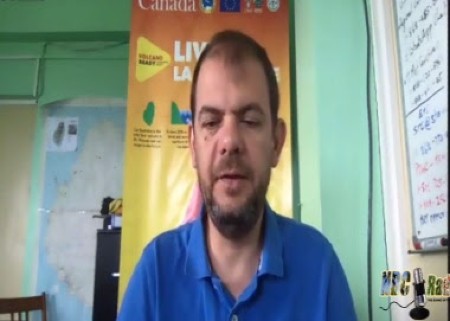Volcanologists Warn Despite Low Activity, La Soufriere Still in State of Unrest
KINGSTOWN, St. Vincent – Scientists monitoring the La Soufriere volcano that erupted explosively on April 9, say despite seismic activity remaining low since the last major explosion and ash venting on April 22, the volcano continues to be in a state of unrest.
 Dr. Adam StintonThey warn that escalation in activity can still take place with little or no warning and that in the last 24 hours, Thermal anomalies continue to be detected by the NASA FIRMS alert system.
Dr. Adam StintonThey warn that escalation in activity can still take place with little or no warning and that in the last 24 hours, Thermal anomalies continue to be detected by the NASA FIRMS alert system.
“These have been persistent since the 22 April explosion. Thermal anomalies indicate that there is a source of heat within the crater and are most likely from a small body of magma left over, close to the floor of the Summit Crater,” the Seismic Research Centre (SRC) of the University of the West Indies (UWI) said in its latest bulletin.
It said that in the last 24 hours, only a few long-period and volcano-tectonic earthquakes have been recorded and that the volcano is at alert level Orange, down from the previous Red.
Volcanologist, Dr. Adam Stinton, speaking on the state-owned NBC Radio, said that most of the earthquakes recorded over the last weekend, were “too small to be felt”.
He warned residents to be careful as the island gears for the hurricane season which starts on June 1 and the possibility of more lahars (mud slides) as a result of the rains.
“With the approaching hurricane season, it is inevitable there will be more lahars in pretty much all of the drainages, all the valleys around the volcano that have been affected by ash fall and pyroclastic flows and previous lahars from the eruptions.
“If there is enough rain it is possible that there will be large lahars than already been experienced following the rains we had in mid-April,” he said, adding that “lahars remain the major hazard at the moment from this volcano”
Stinton said if heavy rains are seen on the volcano, people should stay out of any valleys that are or near to the volcano.
“These lahars will be pretty fast-moving mixture of water, mud, debris, ash, of trees…of anything sitting on the slopes and has the potential to be washed down will be included in these lahars. They move very fast…and people in those locations (bottom of the valleys) when rain is forecast or they see heavy rains, move to higher grounds is the safest thing to do”.
The volcanologist said he has been studying the pyroclastic flows associated with the eruption of the La Soufriere volcano describing his findings to date as “interesting.
“I have been working primarily of the deposits in the aftermath of the valley…on the Leeward side of the volcano and there some interesting deposits there. There are three or four different types of pyroclastic flow deposits and they seem to be related to different stages of the eruption.
“I am not going to go into too much detail really at the moment but it is interesting to see the sort of changes in the pyroclastic flow deposits based on what are carried during the explosive phase and as I study them further. We will be able to learn more about what was happening during the explosive phase based on what we see inside those pyroclastic flow deposits,” he added.
AT the height of the explosion last month, thousands of people were evacuated and placed into shelters. Some of them have since been allowed to return to their homes.


